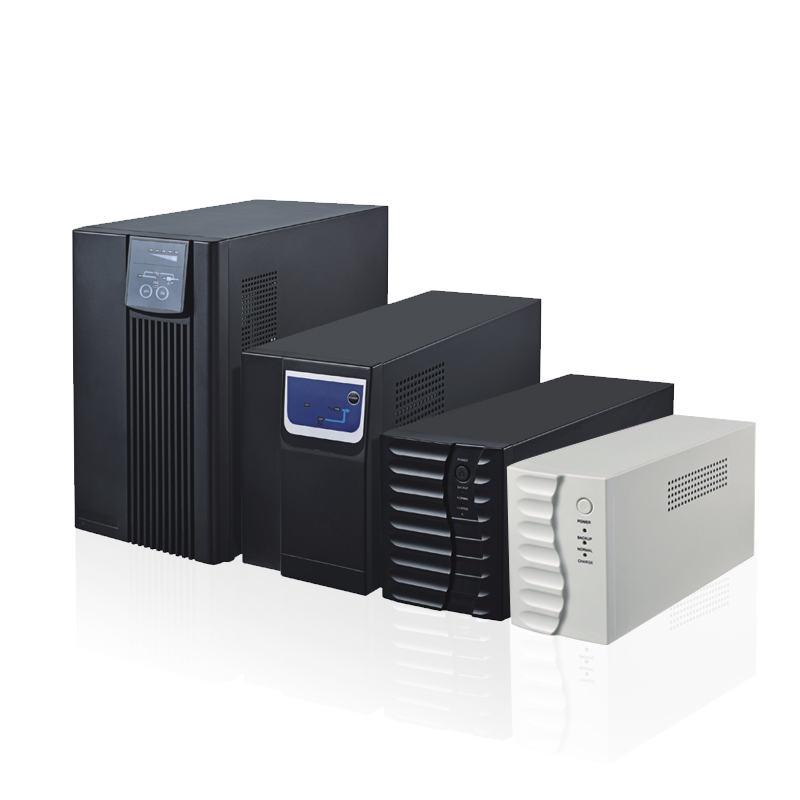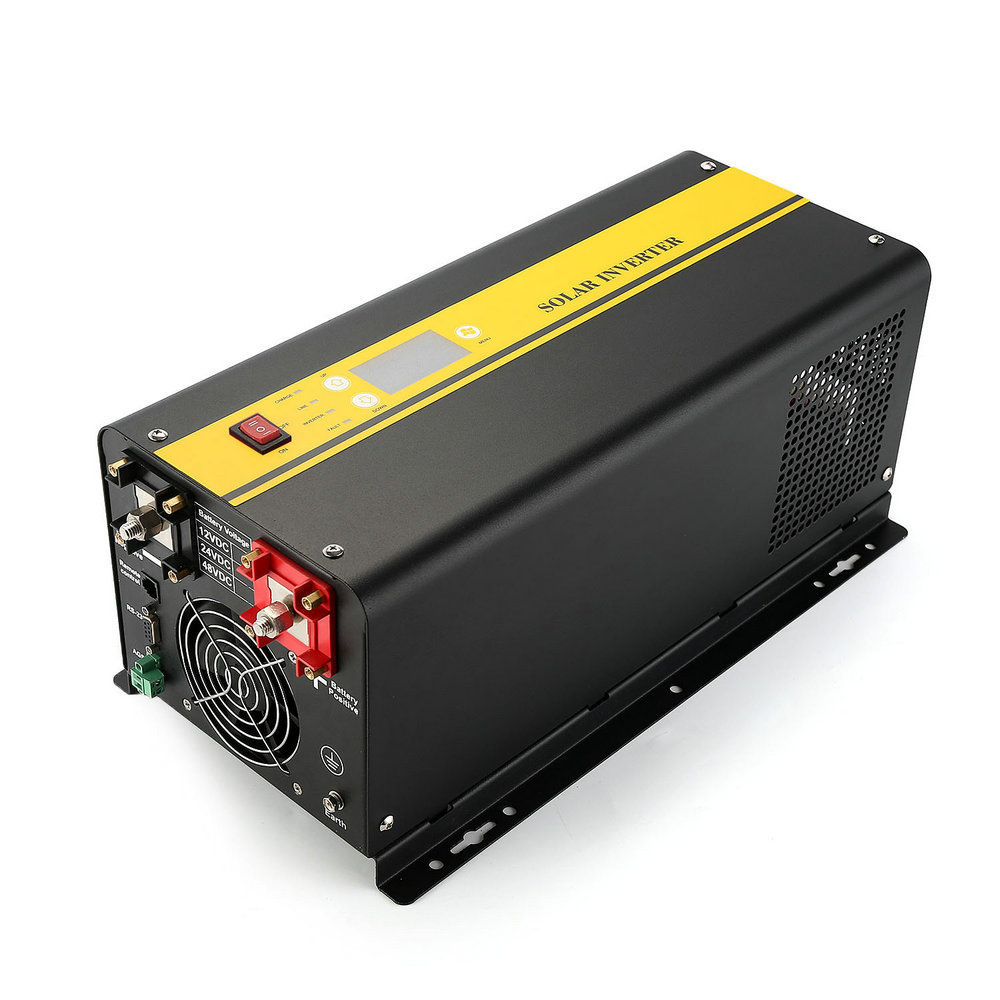Under normal circumstances, the battery is charging. When the power fails, the inverter switches to the working state urgently and converts the DC power provided by the battery into a stable AC power output. Off-line UPS has a switching time problem (generally between 2 and 10 milliseconds), so it is not suitable for use in critical places where power supply cannot be interrupted. The switching power supply of the computer itself should be able to maintain about 10 milliseconds when the power is turned off, so the personal computer system generally does not have problems because of this switching time!

Always keep the inverter in working state, convert the external AC power into DC power through the circuit, and then convert the DC power into high-quality sine wave AC power through the high-quality inverter and output it to the computer. The main functions of the online UPS(Double conversion true online UPS-CE series) under power supply conditions are voltage stabilization and prevention of electric wave interference; during a power outage, a backup DC power supply (battery pack) is used to power the inverter. Since the inverter has been working, there is no problem with switching time, which is suitable for occasions with strict requirements on the power supply!(Line interactive UPS-AK LCD series for personal computer)
Input difference
Get AC power directly, and use AC-DC inverter power for electronic equipment. The offline UPS gets AC power and is charged, but the charged AC-DC inverter power supply is only used in the event of a power failure.
Operating temperature difference
The online UPS always supplies power to electronic equipment. It is charged, and then provides power to the device, the working time and working temperature are longer and higher. The offline UPS only enters the screen during a power failure and will only be heated after using it for more time.
Differences in parts used
To maintain its operating frequency and continuous power supply to electronic equipment, an online UPS requires many components, so it must endure a higher operating temperature. The operation time of the offline UPS is really short, and the components often do not heat up. Only under extreme conditions such as long-term power outages, longer operating time is required, and the use time is not long, because the requirements for parts are relatively low.
Differences in battery usage
During the use of electronic equipment, the online UPS always uses the battery, and the battery is used for a long time. The offline UPS only uses the battery when there is a power failure.
Extreme voltage distortion difference
The online UPS is designed to deal with this extreme voltage fluctuation. No matter what the voltage fluctuation of the main power supply is, there is no need to worry, and it can be almost fixed at a specific frequency. The greater the voltage fluctuation, the more offline UPSs are used. Frequent handovers may cause handover delays, or may eventually reduce its performance, and the output remains within a controllable range.
Reliability difference
Online UPS will cause unreliable service when you use it for a long time. Offline UPS can provide reliable service because it uses fewer parts and lowers operating temperature.
Power supply time difference
The online UPS provides 10-30 minutes of power supply time, requiring more batteries and maintenance work. The offline UPS system provides 60 seconds of full load power supply, which is enough to support the smooth switch of the load to the backup engine start.
Installation differences
Online UPS requires precious indoor space or dedicated rooms. The offline UPS system is suitable for indoor or outdoor installation. Outdoor installation can significantly reduce installation costs.
Efficiency difference
Online UPS adopts an online rectifier and inverter, and the energy efficiency is usually 90% to 92%, including the air conditioning part. The energy efficiency of the offline UPS system is 98% to 99%, which is 6% to 9% higher than that of the traditional UPS system, reducing operating costs.

Ups’ uninterruptible power supply is an uninterruptible power supply with an energy storage device and constant voltage and constant frequency with an inverter as the main component. It is divided into backup type, online type, and online interactive type. Electric voltage regulator, at the same time, it also charges the battery in the machine; when the mains power is interrupted, the UPS immediately supplies 220V AC power to the load through the inverter conversion method, so that when the power is cut off, the machine room can be guaranteed Of servers will not power off.
The regulated power supply cannot provide backup power for the server when the mains power is interrupted. It is only designed for voltage instability. It is mainly used for the protection of back-end equipment. The protection function of the equipment is more complete. If your unit voltage is unstable, You can use a regulated power supply in case of sudden highs and lows, but the machine will lose power after a power failure. The ups power supply has a voltage stabilizing effect and can also be used as an emergency power supply.
If you can choose according to your actual situation when you buy products, you can choose to buy a regulated power supply to protect your machine stability if you don’t stop power once a year. Of course, if you often have power outages, buy an uninterruptible power supply. It is still necessary.
When the input voltage is 90% of the rated voltage, and the output load is 100% or the input voltage is 110% of the rated voltage, and the output load is 0, the output voltage should be kept within the range of plus or minus 3% of the rated value.
When the input voltage is 90% or 110% of the rated voltage, one phase of the output voltage is no load, the other two phases are 100% rated load or two phases are no-load, and the other phase is 100% load, the output voltage should be Keep it within the range of plus or minus 3% of the rated value, and the phase difference should be kept within 4 degrees.
When the input DC voltage of the UPS inverter changes by plus or minus 15% and the output load changes from 0% to 100%, its output voltage value should be kept within plus or minus 3% of the rated voltage value. This indicator is superficially duplicated with the aforementioned indicator, but in fact, it is more demanding than the previous indicator. This is because when the input signal of the control system changes in a large range, it shows obvious nonlinear characteristics. If the output voltage does not exceed the allowable range, the circuit requirements are higher.
UPS can't start
The UPS is started by DC. When the battery is not connected, the battery is low, or the battery has problems, the UPS cannot start. There are several similar situations below:
The newly installed UPS cannot start: check whether the battery connection plug on the rear panel of the UPS is connected, and check whether the battery is connected. Since the new battery will self-discharge during storage, the UPS cannot start when the battery is in a low power state. At this time, you need to connect the UPS to the battery and the mains. Press the Test button on the front panel of the UPS. Although the UPS panel indicator will not light, the UPS will charge the battery. After charging for a period of time, press the Test button again to start the work.
After the UPS inverter has been working for a period of time, the UPS cannot start: it is also because the battery is low and needs to be charged.(Low frequency DC to AC solar inverter with MPPT charger TPS series)

The UPS cannot be started after the battery has been used for about 2 years: According to the usage of most customers, the capacity of the battery will generally decline after two years of use. If the battery cannot delay A new battery needs to be replaced.
1. It is likely that there is a problem with the connection between the battery and the battery or between the battery and the UPS, such as the connection point is not strong or the connection point is oxidized, then you need to remove the oxide and reconnect.
2. It may be that the fuse connecting the UPS and the battery is broken. If the fuse is broken, replace it with a new one.
3. The connection between the UPS and the battery is very long, very thin, or there is a connection point in the middle, so a large voltage drop occurs, which prevents the UPS from starting.
The backup UPS can work normally when there is mains power. When the mains power is interrupted, the inverter has an output, but it will generate a lot of noise and the output voltage is low. At this time, it is necessary to detect whether the power is normal. If the power is normal, continue to detect whether the signal of the pulse width output circuit is normal. When it is normal, check whether the output of the drive circuit is normal. Follow this step to effectively find the cause of the UPS failure.
The UPS connected to the mains power grid can always hear the sound of the internal relays repeatedly when it is turned on, and the battery voltage of the UPS panel is low, the indicator light is always on, and the buzzer can always hear the sound inside the machine. Therefore, we should check whether the battery voltage is low, measure the battery voltage with a multimeter, and then charge all batteries in parallel. After installation, if the above situation still occurs, only the battery needs to be replaced.
When the UPS is connected to the mains, it can output normally, but when the mains is interrupted, there is no output, and the buzzer sounds long. There is no output, you should check the battery and inverter problems. The first measure of whether the battery voltage is low, if it is low, then check whether the battery charging circuit is faulty. There is no problem with the battery. Check whether the drive circuit of the inverter can work normally. If the drive circuit can output normally, the inverter is damaged.
If the inverter drive circuit is not working properly, you should check whether the waveform generation circuit has a PWM control signal output. If it does, the inverter drive circuit is malfunctioning. On the contrary, if not, check whether the output is stopped due to the protection circuit. Check the specific reasons for protection. If the protection circuit does not work and the operating voltage is normal, the waveform generation circuit has no PWM waveform output, the waveform generation circuit is damaged.
Mains environment
1) Power grid interference:
If there is very serious interference in the power grid, such as voltage sag and other power interference, it may cause failures such as power failure of the UPS.
2) A leakage protector is installed at the input end of the UPS: UPS is a large leakage current. When the UPS is turned on, it will cause the leakage protector to trip. If you need to install a leakage protector, you need to connect the leakage protector to the output line of the UPS.
3) The air switch at the input end of the UPS trips:
This phenomenon may be caused by the small capacity of the air switch at the input end of the UPS. Since the starting current of the UPS is relatively large, the capacity of the front-end air switch is required to be large enough.
4) Frequent transitions between the UPS inverter state and the online state: it may be caused by fluctuations in the mains. If you use a generator, this will happen.
It is difficult to prevent a UPS without lightning protection components and a UPS equipped with lightning protection components that do not meet national standards from being struck by lightning. If it can truly prevent it from being struck by lightning, the following requirements should be met:
Set up a complete lightning protection system that has undergone countless simulations and practice on the outside of the whole building equipped with UPS equipment, and install a lightning protection ground network according to economic output.
In the process of grounding in the equipment room, AC or DC work and lightning protection grounding should share a set of grounding devices. If they must be grounded separately, a potential site coupling must be set between the two grounds of the equipment. The more equipment, for the system Overall safety and reliability, more necessary measures should be established.
Really do lightning protection on the line. Install high-energy surge arresters for parallel power supplies on the total power output distribution cabinet. Also, install the appropriate amount of parallel low-voltage power surge arresters for the air switch of the power distribution cabinet in the same computer room. Install corresponding arresters on the UPS equipment and the load. Strictly follow the incoming standard to prevent the magnetic field induced by the strong current generated by the lightning strike from damaging the equipment circuit.